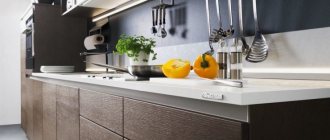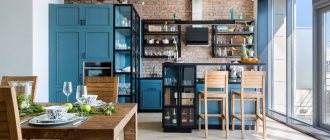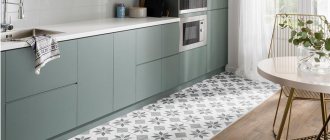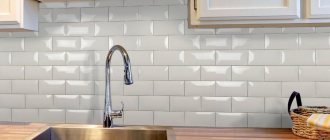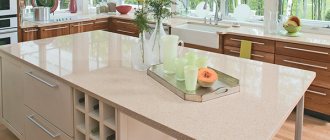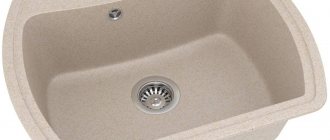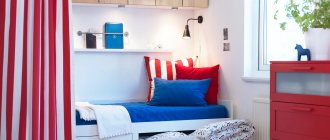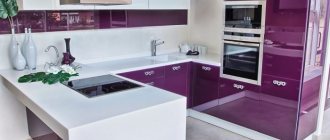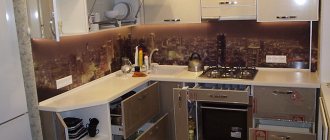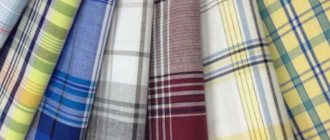/Accessories and decor/Decoration/
A mirror in the kitchen visually enlarges the space, enhances lighting and simply adds chic to the interior. Modern mirror finishes come in such a variety of shapes, colors and sizes that you can easily find something that can decorate your kitchen. In this material, we have collected a selection of 50 beautiful photos, a review of materials, tips on care and design, and also presented 7 ideas for using mirrors in the kitchen interior.
About materials
The mirror can be made from polystyrene, acrylic or glass. Mirrors made of polystyrene cannot be used in the kitchen, as they are too afraid of moisture and mechanical damage. So let's take a closer look at the last two options.
An acrylic mirror is 5 times more impact resistant, which means it is safer than a glass one. In addition, it is easier to install, cut and transport. The disadvantages include its lower scratch resistance and high cost.
- Since an acrylic mirror is 2 times lighter than a regular mirror, it is most often used to decorate ceilings and furniture facades. In other cases, for example, to create a mirrored splashback in the kitchen, it is better to choose traditional glass material.
Sheet mirror in a kitchen apron with plinth
The following finishing materials are made from both acrylic and glass mirrors:
- Sheet panels. Most often, walls, furniture facades and kitchen aprons are finished with large-format panels. Sheet mirrors can have a thickness of 4 or 6 mm and are found in the following sizes (depending on the manufacturer): 255×160 cm, 275×160 cm, 321×225 cm, 321×255 cm, and 321×600 cm. For precise The panel dimensions are adjusted during the installation process.
- The thicker the sheet mirror, the stronger, more truthful and less demanding it is regarding the evenness of the base. Therefore, for finishing walls and kitchen aprons, it is better to choose panels with a thickness of 6 mm. And for the manufacture of wall panels, ceiling cladding, facades, or for framing in a baguette, it is better to choose 4 mm or 5 mm mirrors.
- Mosaic tiles. Most often, mirror mosaics in the kitchen are used to cover aprons, walls and curved surfaces. It is sold in the form of matrices with a flexible base, but some manufacturers offer a mosaic of individual “chips”. Common chip sizes are 2x2 cm and 3x3 cm. Mirror mosaic has many advantages. Firstly, stains and stains are less noticeable on it. Secondly, the mosaic is subject to local repair. Thirdly, it does not require a perfectly flat base. And of course, it is simply very impressive and variable in design. It also has disadvantages - relatively high cost and the need to periodically clean the seams. In addition, it does not have reflective properties, which means it will not increase the space.
An example of decorating a dining area with mirrored tiles with bevel and lighting
- The most universal grout colors for mirror mosaics are white and graphite.
- It is better and safer to choose a mosaic with a polished edge or with a bevel.
- Tiles of different sizes and shapes. It is produced as a “hog” tile, in the form of squares, triangles, hexagons and other geometric or fantasy shapes. From such tiles you can create a mirrored kitchen apron or, say, a wall panel.
Production of mirror aprons in Russia
After choosing a design project, we move on to the stage of purchasing material. From many manufacturers you need to choose one and the best.
There are many companies. These are both domestic, for example, the Moscow Mirror Factory or Steklokolor, and foreign. Choose the one who offers the optimal terms, prices and order parameters for you.
Additional capabilities of manufacturers will attract special attention:
- decorative painting and photo printing of images on the mirror;
- artistic frosting of glass to match the furniture, curtains, walls, ceiling;
- LED lights.
- creating an antique effect.
The most active sellers of mirror panels in Russia: Russian glass factory apron.ru, Moscow mirror factory, skinali.com company, Steklokolor, Glass Mirrors and Interior.
What you should pay attention to when reading reviews about the manufacturer and communicating with a consultant:
- technical ability to fulfill the order;
- terms of registration, production and delivery;
- the ability to install an apron on site (not every apartment can accommodate a large mirror 2-3 m long);
- the presence of a protective film that will protect you from splinters in case of possible damage to the tiles.
Comparing prices is not so easy, since one company may offer an all-inclusive package, while another will first provide accurate calculations with detailed specifications. But at the initial stage, you can estimate the cost of the apron itself with the necessary measurements, its delivery and installation.
No one will do it quickly, cheaply and efficiently, and this is worth remembering. Time reserve, careful selection of the manufacturer and competent assessment of the design solution itself will guarantee an excellent result.
And since we are talking about design solutions, we will talk about various options for using mirror elements in finishing a kitchen apron.
About the edge
The edge is an important part of the mirror. If the edges of the canvas are not processed in any way, then it (including the amalgam) becomes more vulnerable due to existing microcracks and chips. Therefore, it is worth choosing mirrors with a polished edge (Euro-edge) or with a bevel - edges beveled at an angle of up to 40 degrees. Beveled mirrors are almost eternal; they shine more because they refract light.
- The width of the bevel, depending on the size and thickness of the material, can range from 4 to 45 mm.
How to properly place a mirror in the kitchen - advice from Feng Shui experts
Those who want to bring harmony to the kitchen space need to:
- The mirror reflected the dining table. It is believed that this will attract material well-being and family well-being. This pose is also useful for those who are just dreaming of a wedding: you can always check the amount of food eaten at one time. Looking in the mirror, you need to experience only positive emotions, then there will be even more of them.
- The entrance to the kitchen was reflected.
- If dirty trash cans or dishes are not visible in the mirror, this will increase the negative energy coming from these items.
It is always worth remembering to appreciate only the positive aspects and carefully monitor what you see in the reflection.
Variations in mirror design
The type of mirror surface can be very different. In addition to the traditional smooth silver fabric, you can choose the following varieties:
- Colored mirror - the colors of gold, graphite, champagne, as well as blue, green, red, pink and purple shades are achieved due to the base glass colored in the mass.
- Satin (satinato) is a mirror matted using chemical etching. The entire canvas can be satin or just the pattern as shown in the photo below. A satinato finish is similar in appearance to a sandblasted finish, but looks sleeker and smoother.
Satinato in a kitchen apron
- Aged - the effect of a clouded surface with peeled amalgam is also achieved using chemical etching or using direct printing applied under a layer of amalgam. Aged mirrors fit best into classic kitchen interiors.
- With a pattern under the amalgam - the mirror can have any design or pattern you want. It is applied to the film using direct UV printing, which is then glued to the glass and covered with amalgam.
- With a sandblasting pattern - using the sandblasting method, you can apply a pattern on the outside of the mirror (then you get the effect of frost) or on the reverse side, that is, on the amalgam (then you get the effect of a pattern inside the mirror). An important nuance - a sandblasted mirror must be framed. In addition, keep in mind that it is not suitable for covering an apron, as it requires careful handling.
The role of kitchen sizes
Large kitchens:
- If the apartment has high ceilings, which is why the distance between the cabinets and the work area is quite large, then it would be advisable to combine the mirror with any other material used in the interior.
- The best idea for a large space would be to use mirror mosaics: it will dilute the interior and add some chic and modernity to it.
Small kitchens:
- It is necessary to use either a solid mirror surface or a minimal pattern on it so as not to lose the effect of visually increasing space. To decorate a small kitchen in a loft style, mirrored brick tiles are suitable, and for a classic style, solid aged panels.
Visual increase in space
Most often, this texture is chosen precisely for this purpose. Indeed, due to its properties, a mirror visually expands the room and makes it brighter.
If you place the kitchen set next to the window, then a mirrored apron will help to almost double the space .
Thus, a mirrored apron is indeed a very successful design element. It has a number of undeniable advantages that set it apart from other textures and materials. If you correctly distribute the space and fit it into the interior, then it will perform its immediate functions and also please the eye for several years.
Do not forget that this function will be most successfully performed by solid mirror panels; tiles will crush the space, which can minimize the desired effect.
About installation
Mirror structures must be mounted on flat surfaces. It is especially important to prepare the walls well if you are installing a sheet mirror splashback or a full-wall mirror instead of wallpaper. There are three ways to mount the material:
- For fastening (with drilling);
- For glue or liquid nails for mirrors (without drilling);
- On hooks (hidden installation with wall drilling).
Of the listed methods of fastening, the most reliable is adhesive.
Features of laying mirror tiles
The technology for installing the apron largely depends on the size of the panels. But regardless of the type of tile, you should start by leveling the walls. And only after preparing a flat surface can you proceed to assembling the mirror apron.
The entire process consists of several separate tasks:
- Special glue is applied to the prepared wall surface.
- The apron element is applied to the wall and held for 10-15 seconds.
- The following elements are installed evenly using crosses and periodically checking with a long level to ensure compliance with the intended lines.
- The seams between the tiles are rubbed with transparent silicone no earlier than after 48 hours.
- The kitchen set and other furniture elements are placed another day after grouting the joints.
About care
Is it practical to use mirrors in the kitchen? On the one hand, they are not afraid of alkalis, acids, water, or soft brushes. The surface of the mirror is smooth and non-porous, so dirt and even grease stains can be easily washed off. On the other hand, mirrors require frequent cleaning, because they are beautiful only in their pure form. However, a lot here depends on their location. For example, a mirrored apron is a solution either for those who are not afraid of cleaning, or for those who rarely cook. But a mirror hung, say, in the dining area, only needs to be wiped once a week.
- The easiest way to wipe mirrors is with a microfiber cloth.
How to beat a mirror in the kitchen
Much in the perception of a room depends on where to hang the mirror in the kitchen. Don't think that it can only be used in the traditional way - glass in a frame. There are many interesting ways to use mirrors. Let's look at the most successful ones.
There are many non-standard options for using mirrors in the kitchen.
Mirrors are often used to expand the space - this technique looks especially impressive in a small kitchen in a Khrushchev-era building or other small-sized apartments. In this case, the surface reflects the opposite wall, visually making the room twice as wide.
A neat mirror can visually enlarge the kitchen.
On the other hand, it is precisely because of this property that in spacious kitchens you should not hang large mirrors on the entire wall - this can easily upset the balance of perception and make the room too bulky and uncomfortable.
Mosaics and mirror panels look very unusual. It is important to choose the right shape and decide where to hang such a mirror - a refracted reflection may not look very aesthetically pleasing, so it is better if a smooth wall is reflected on the surface of the structure.
The mosaic looks impressive, but it needs to be carefully thought out.
A thin strip of mirror on the apron, illuminated from above by an LED strip or spotlights, will make cooking on the countertop much more comfortable. This way, the countertop will be well lit and you will be able to see your food from all angles without having to turn it.
Illuminated mirrors are a fashion gimmick.
True, there is also a minus - you will have to clean the mirror after almost every firing, since all the splashes and marks will be visible on it. On the other hand, with modern detergents this is unlikely to be a problem for you.
A very bold and unusual technique is to use a mirror instead of an apron. Most often it is used for kitchen sets with narrow countertops, so they visually become wider.
A mirror is popular instead of an apron.
Please note that the workspace will now require a very careful approach. You will not only have to regularly clean the apron, but also keep the tabletop clean - crumbs and stripes on the set are unlikely to add attractiveness to the reflection.
Also try to order the strongest possible mirror glass - the apron is often subject to mechanical stress, so you only risk breaking regular glass. This is fraught not only with the need to replace the apron, but also with injuries, even quite serious cuts.
Sometimes mirrors replace kitchen facades. In this case, strength also plays an important role. By the way, it is not necessary to cut the facades directly with mirror glazing. Using shiny metal surfaces, glossy shiny acrylic surfaces can give a lighting effect...
It is better to replace glass on facades with metal.
Try experimenting with materials. In addition, caring for pure mirror facades is quite complicated - it is quite possible to find a less capricious option that will look just as aesthetically pleasing, but benefits in terms of practicality.
In addition, it should be borne in mind that mirrored facades do not fit any style of kitchen design; for example, they are almost impossible to imagine in a classic interior.
In a classic style, mirrors look best as decoration.
Some design solutions involve hanging a mirror in the kitchen near the sink. This technique may look very elegant, but there are a number of nuances to consider:
- No matter how carefully you wash the dishes, drops of water will constantly fall on the mirror surface. This means that you will have to constantly clean the glass.
- It is very important to choose the right frame for the mirror. It should be a moisture- and steam-resistant material that does not deform after a couple of months.
- Pay attention to how tightly the edge of the frame fits against the glass. If there are gaps, moisture will get in and mold may develop over time. This is fraught not only with an unpleasant odor and untidy appearance - mold from such a source can easily spread throughout the kitchen.
- If a mirror is constantly exposed to steam, it will fade over time. You will need special cleaning products. If you are against using chemicals in the kitchen, you can replace them with a vinegar solution. But remember that you need to clean the surface regularly, only then will it shine.
The kitchen mirror above the stove should also be very resistant to heat and steam. Avoid using plastic frames - your choice is metal and wooden frames with special impregnation.
In this case, the glass must be especially strong.
In addition, you will need a special polish to prevent steam from forming on the glass, otherwise the mirror will fog up all the time.
Consider the angle of reflection of the mirror - it is better if the image in it is attractive. In this case, it’s a good idea to hang a special hanger above the stove and on it - nice copper or ceramic pots and kitchen utensils.
Important! Wherever you decide to hang a mirror in the kitchen, imagine what will be reflected in it. Sometimes a little aesthetic consideration can ruin the entire perception of even the most thoughtful kitchen in terms of design.
A mirror hanging on the front of the refrigerator can look very elegant. But here you need to think about the degree of accuracy of your family members. Constantly scrubbing prints off a reflective surface isn't much fun. If there are small children in the house, you should abandon this idea - it will take a lot of effort to keep the mirror in good condition.
Sometimes it is more rational to replace the mirror with reflective equipment.
In addition, it is very important to properly fasten the mirror to the refrigerator: if the fasteners are not strong enough, there is a risk that the glass will simply fall under its own weight. As an alternative, it is recommended to use plastic mirrors or mirror films. These options are much simpler, cheaper, and much easier to fix.
As you can see, there are many options for decorating a kitchen with mirrors in the work area. As for the dining area, you can also find very interesting techniques here.
Using a mirror on your dining table will make your kitchen feel more inviting.
For example, a mirror above the dining table can make the dining area appear larger and more comfortable. We recommend lighting the mirror with small lampshades in the corners to create a cozy and familiar dining area.
For the same purpose, mirrors are hung in the kitchen above the sofa. However, it is important to ensure that the latter has a fairly wide back: touching the back of the head with a mirror is not only unpleasant, but also dangerous.
There are more ambitious ways to add mirrors to your kitchen. For example, you can design a completely mirrored ceiling. However, keep in mind that this trick is only suitable for people who are used to keeping the kitchen in perfect order, otherwise you will have to immediately learn how to clean up the slightest mess. Any defect will immediately attract double attention. In addition, the ceiling itself should be cleaned frequently, especially above the stove and sink where steam loss is most common.
A broad but complex solution.
As for a mirror floor, we don't recommend it in the kitchen for the same cleaning reasons: you'll have to wash it after almost every meal. Therefore, such a coating can tire even the most careful housewife.
